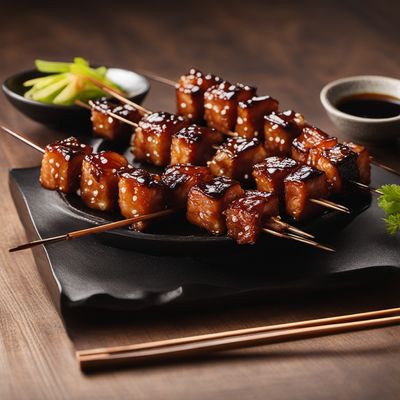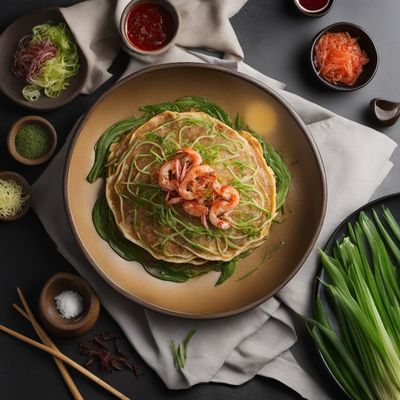
Recipe
Kishimen - Japanese Flat Udon Noodles with Soy-based Sauce
Savory Delight: Master the Art of Kishimen - Traditional Japanese Flat Udon Noodles
4.7 out of 5
Kishimen is a beloved dish in Japanese cuisine, originating from the Nagoya region. This recipe features wide, flat udon noodles served in a flavorful soy-based sauce. It is a comforting and satisfying dish that showcases the simplicity and elegance of Japanese flavors.
Metadata
Preparation time
15 minutes
Cooking time
15 minutes
Total time
30 minutes
Yields
4 servings
Preparation difficulty
Easy
Suitable for
Pescatarian, Dairy-free, Nut-free, Low-fat, Low-sodium
Allergens
Wheat (in udon noodles), Soy (in soy sauce)
Not suitable for
Vegan, Vegetarian, Gluten-free, Paleo, Keto
Ingredients
-
250g (8.8 oz) udon noodles 250g (8.8 oz) udon noodles
-
2 tablespoons vegetable oil 2 tablespoons vegetable oil
-
2 cloves garlic, minced 2 cloves garlic, minced
-
1 small onion, thinly sliced 1 small onion, thinly sliced
-
200g (7 oz) chicken breast, thinly sliced 200g (7 oz) chicken breast, thinly sliced
-
2 cups (470ml) dashi stock 2 cups (470ml) dashi stock
-
4 tablespoons soy sauce 4 tablespoons soy sauce
-
2 tablespoons mirin 2 tablespoons mirin
-
1 tablespoon sugar 1 tablespoon sugar
-
2 green onions, thinly sliced 2 green onions, thinly sliced
-
Tempura crumbs (optional, for garnish) Tempura crumbs (optional, for garnish)
Nutrition
- Calories (kcal / KJ): 380 kcal / 1590 KJ
- Fat (total, saturated): 8g, 1g
- Carbohydrates (total, sugars): 55g, 6g
- Protein: 22g
- Fiber: 3g
- Salt: 2.5g
Preparation
-
1.Cook the udon noodles according to the package instructions. Drain and set aside.
-
2.In a large pan, heat the vegetable oil over medium heat. Add the minced garlic and sliced onion, and sauté until fragrant and translucent.
-
3.Add the sliced chicken breast to the pan and cook until it is no longer pink.
-
4.In a separate bowl, combine the dashi stock, soy sauce, mirin, and sugar. Stir until the sugar is dissolved.
-
5.Pour the sauce mixture into the pan with the chicken and onions. Bring to a simmer and cook for 5 minutes.
-
6.Add the cooked udon noodles to the pan and toss gently to coat them in the sauce. Cook for an additional 2-3 minutes, until the noodles are heated through.
-
7.Serve the Kishimen hot, garnished with sliced green onions and a sprinkle of tempura crumbs, if desired.
Treat your ingredients with care...
- Udon noodles — Cook the noodles according to the package instructions, but make sure to slightly undercook them as they will continue to cook when added to the sauce.
- Dashi stock — For a homemade dashi stock, combine 4 cups of water with a piece of kombu (kelp) and a handful of dried bonito flakes. Let it steep for 30 minutes, then strain before using.
Tips & Tricks
- To add more depth of flavor, you can sauté the garlic and onions until they are caramelized before adding the chicken.
- For a vegetarian version, you can substitute the chicken with tofu or mushrooms.
- If you prefer a spicier kick, add a small amount of chili oil or shichimi togarashi (Japanese seven spice) to the sauce.
- Kishimen is best enjoyed immediately after cooking to maintain the perfect texture of the noodles.
- Leftovers can be stored in an airtight container in the refrigerator for up to 2 days. Reheat gently on the stovetop or in the microwave.
Serving advice
Serve Kishimen hot in individual bowls, garnished with sliced green onions and a sprinkle of tempura crumbs for added texture. Pair it with a side of pickled vegetables or a simple cucumber salad to balance the flavors.
Presentation advice
When serving Kishimen, ensure that the noodles are evenly coated in the sauce and arranged neatly in the bowl. Garnish with a generous amount of sliced green onions and a sprinkle of tempura crumbs for an appealing visual contrast.
More recipes...
For Japanese cuisine » Browse all
More Japanese cuisine dishes » Browse all

Japanese Potato Salad
Japanese potato salad is a creamy and refreshing side dish that is popular in Japan. It is made with potatoes, cucumbers, carrots, and mayonnaise.

Negitoro gunkan maki
Scallion and Tuna Belly Gunkan Maki
Negitoro gunkan maki is a type of sushi that is made with small, oval-shaped mounds of sushi rice wrapped in a strip of nori seaweed and topped...

Sekihan
Red bean rice
Sekihan is a traditional Japanese dish that is made with glutinous rice and azuki beans. It is a festive and flavorful dish that is often served...






